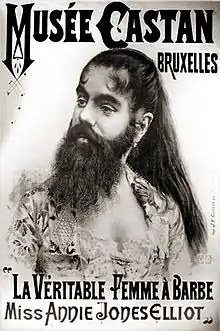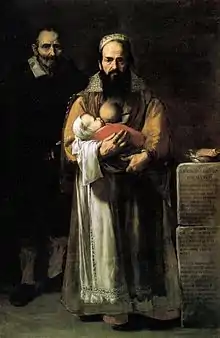Bearded lady
A bearded lady (or bearded woman) is a female, typically a sideshow performer, with a naturally occurring beard normally due to the condition known as hirsutism or hypertrichosis. Hypertrichosis causes people of either sex to develop excess hair over their entire body (including the face), while hirsutism is restricted to females and only causes excessive hair growth in the 9 body areas mentioned by Ferriman and Gallwey.

Background
A relatively small number of women are able to grow enough facial hair to have a distinct beard. The condition is called hirsutism. It is usually the result of polycystic ovary syndrome which causes excess testosterone and an over-sensitivity to testosterone, thus (to a greater or lesser extent) results in male pattern hair growth, among other symptoms. In some cases, female beard growth is the result of a hormonal imbalance (usually androgen excess), or a rare genetic disorder known as hypertrichosis.[1] In some cases a woman’s ability to grow a beard can be due to hereditary reasons without anything medically being wrong.[2]
There are numerous references to bearded women throughout the centuries, and Shakespeare also mentioned them in Macbeth:
you should be Women,
And yet your beards forbid me to interpret,
That you are so.— 138–46; 1.3. 37–45
However, no known productions of Macbeth included bearded witches.[3]
Sometimes it is caused by use of anabolic steroids. Cultural pressure leads most to remove it, as it may be viewed as a social stigma.
The "bearded lady" is a cliché—a staple of a carnival sideshow.
Race
Darwin’s ideas on sexual selection that influenced the perception of women with excess facial hair were applied differently across race. Black women who had excess facial hair were actually perceived as evidence of human’s evolution from apes, whereas white women with excess facial hair were perceived as diseased. A beard on a white woman only challenged her sex, whereas a beard on a black woman challenged her species.[4]
Some famous bearded women were Krao Farini[5] and Julia Pastrana.[6]
Entertainment
Notable examples were the famous bearded ladies of the circus sideshows of the 19th and early 20th centuries, such as Barnum's Josephine Clofullia and Ringling Bros.' Jane Barnell, whose anomalies were celebrated. Sometimes circus and carnival freak shows presented bearded ladies who were actually women with facial hairpieces or bearded men dressed as women, both practices being lampooned by comedian and former circus performer W.C. Fields in the 1939 film, You Can't Cheat an Honest Man.[7]
Notable women with beards

12th century
- Topographia Hibernica written by Gerald of Wales
14th century
16th century
17th century
- Magdalena Ventura, portrait by Jusepe de Ribera (1631)
19th century
- Julia Pastrana
- Krao Farini
- Josephine Clofullia
- Annie Jones
- Alice Elizabeth Doherty ("The Minnesota Woolly Girl", 1887–1933)
20th century
- Clémentine Delait (late 19th century and early 20th century)
- Jane Barnell (late 19th century and early 20th century)
- Jennifer Miller
21st century
Popular Culture
- Lettie Lutz, Keala Settle's character in The Greatest Showman
- A fascination with Wilgefortis grips the narrator of Fifth Business, the 40th-best novel of the 20th century according to the Modern Library's readers' list.[8]
See also
References
- Taylor, Sarah K (June 18, 2009). "Congenital Hypertrichosis Lanuginosa". Emedicine. Medscape. Retrieved December 4, 2009.
- Hamlin, Kimberly A. (2011). "The "Case of a Bearded Woman": Hypertrichosis and the Construction of Gender in the Age of Darwin". American Quarterly. 63 (4): 955–981. doi:10.1353/aq.2011.0051. ISSN 1080-6490.
- Shopland, Norena 'A wonder of nature' from Forbidden Lives: LGBT stories from Wales, Seren Books, 2017
- Hamlin, Kimberly A. (2011). "The "Case of a Bearded Woman": Hypertrichosis and the Construction of Gender in the Age of Darwin". American Quarterly. 63 (4): 955–981. doi:10.1353/aq.2011.0051. ISSN 1080-6490.
- Hamlin, Kimberly A. (2011). "The "Case of a Bearded Woman": Hypertrichosis and the Construction of Gender in the Age of Darwin". American Quarterly. 63 (4): 955–981. doi:10.1353/aq.2011.0051. ISSN 1080-6490.
- Trainor, Sean (2014). "Fair Bosom/Black Beard: Facial Hair, Gender Determination, and the Strange Career of Madame Clofullia, "Bearded Lady"". Early American Studies. 12 (3): 548–575. doi:10.1353/eam.2014.0019. ProQuest 1553324492.
- Deschner, Donald (1966). The Films of W.C. Fields. New York: Cadillac Publishing by arrangement with The Citadel Press. p. 139. Introduction by Arthur Knight
- "Readers' List: 100 Best Novels", Random House Modern Library
External links
| Wikimedia Commons has media related to Bearded Lady. |